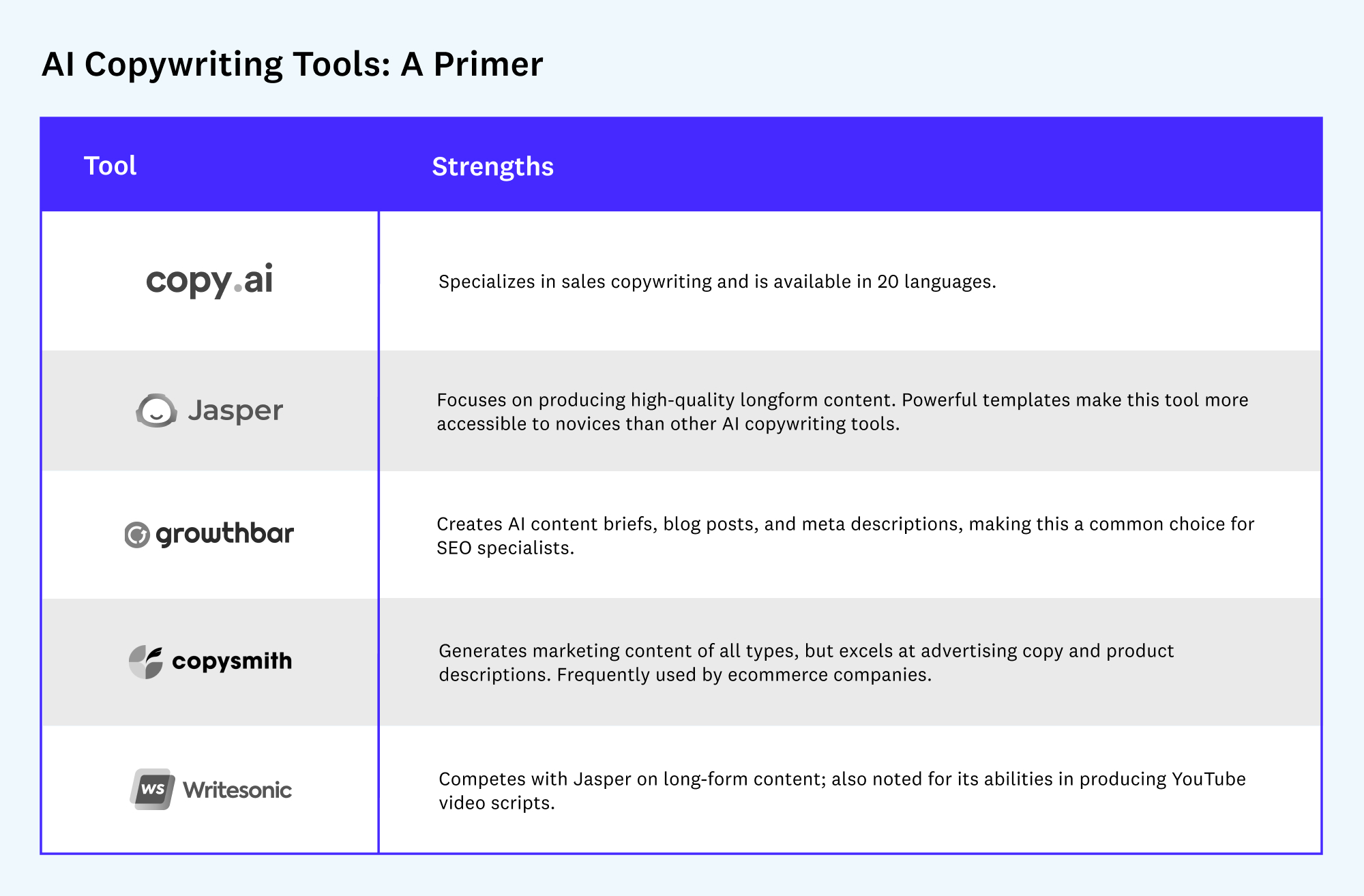Since the beginning of search engines, writers and companies have chased SEO — the slippery science of getting your results high up in Google’s search rankings to improve web traffic. More recently, however, the advent of cheap, easy-to-use AI copywriting tools enabled by GPT-3 has changed the game entirely. While AI-based copywriting has been steadily advancing for years, until recently it has never been good enough to be more than a party trick. We’re just now beginning to see the effects of companies using AI to produce written content en masse.
Already, AI-generated copy is being used to produce SEO-driven content at scale, even as Google claims to penalize such content. However, there are more uses for AI tools than simply evading the tactical cat-and-mouse game that many companies and SEO specialists play with Google. Rather, I see a future in which AI copywriting tools will dramatically increase the productivity and, eventually, quality of copywriters — but where the rise of such tools will also heighten demand for skilled human writers and editors.
Today, the widespread adoption of AI tools like Jasper and CopyAI is sparking new questions: How do AI copywriters stack up against human writers? How is the increased use of AI writing tools impacting SEO and search results? And most importantly for companies and creators, how can you intelligently use this AI revolution to your advantage?
The rise of AI-generated writing, powered by GPT-3
GPT-3 is a neural network machine learning model created by OpenAI that is used to translate written commands and generate text. GPT-3 is effectively AI for the everyman: Though it has been trained with absurdly large datasets — almost 500 billion byte-pair encoded tokens — and conditioned using over 175 billion machine learning parameters, GPT-3 can be used by almost anyone with ease.
GPT-3 requires only a small amount of input text to generate large volumes of relevant and sophisticated machine-generated output text.
In response, numerous automated copywriting applications have emerged that claim to produce high-quality material. Now those tools are upending the quest for SEO.
For many years, the SEO industry has been outsourcing cheap content writing to India and the Philippines. Within the past couple of years, many freelancers from these countries have begun using AI to spit out massive volumes of content. Why wouldn’t they? Google ranks AI-generated writing in search results and increased industry demand means that higher output can make freelancers more money than ever before.
It’s important to note that while much of this content is mediocre, AI copywriters are not inherently inferior; in fact, AI tools can be used to generate content that is indistinguishable from human output. But while AI-generated content is typically grammatically correct, AI copywriters are not always factually accurate, increasing the likelihood of disinformation or fake news. While GPT-3 has the potential to revolutionize the way we create content, we are only beginning to scratch the surface of what this powerful tool can do.
How to use AI copywriting tools as collaborators
Although AI is increasingly playing a role in content creation, there are new ways for human copywriters to remain relevant. GPT-3 promises unprecedented outputs at lightning speed, but the best results to date come from those using AI alongside specialized human editors and writers to produce content. AI-assisted copywriting will eventually impact more than just search strategy and SEO.
While the ways that AI copywriting tools work are many, here are the basic workflows:
- Copywriting: Write a prompt for the AI that includes the document title, content brief, and suggested tone.
- Blog content writing: Write a content brief for the AI that includes the document title, section headers, and tone. Add an empty line after each header and compose content for each section individually.
- Copy editing: Copy and paste text into the AI’s output field. Highlight this text and use the “fix grammar” tool or “rephrase” tool to edit it.
AI is a tool, and like any tool, it must be used correctly to be effective. Used properly, AI copywriting tools can be a valuable asset in any writer’s back pocket. Let’s generalize and say that without AI, an experienced writer can comfortably produce an average of 2,000 words per day. When trained to curate and edit AI-generated content, in my experience the writer’s output can quickly increase to 4,000 or 5,000 words daily, giving them the ability to be more productive with fewer false starts.
AI copywriters can also be used to help new writers learn the ropes by identifying grammatical errors and suggesting structural modifications to make writing more polished and conversational.
Over time, this helps writers improve their sentence structure, grammar, vocabulary, and overall value in the market.
Many different types of AI copywriting tools are available, including Copy.ai, Jasper, GrowthBar, Copysmith, and Writesonic, among others. Each has its own strengths and weaknesses. Some are better at grammar and spelling, while others can help with research and conceptualizing content at a high level.
Five common AI copywriting tools

One point remains across all tools: AI copywriters are not a replacement for human writers — they are best used as an assistant to improve on human efforts. This means that while they can help with some aspects of writing, they should not be solely relied on to produce content in their current state.
Google and the search for quality content
Of course, one of the primary uses for AI copywriting tools is to produce more content for less money, helping companies rank higher on key terms through Google Search. Given Google’s current dominance as a search engine, the company’s perspective on AI-assisted content can have a dramatic impact on the industry.
When the trade publication Search Engine Journal ran the headline “Google Says AI Generated Content Is Against Guidelines” in April, it struck fear in the hearts of SEO specialists worldwid
